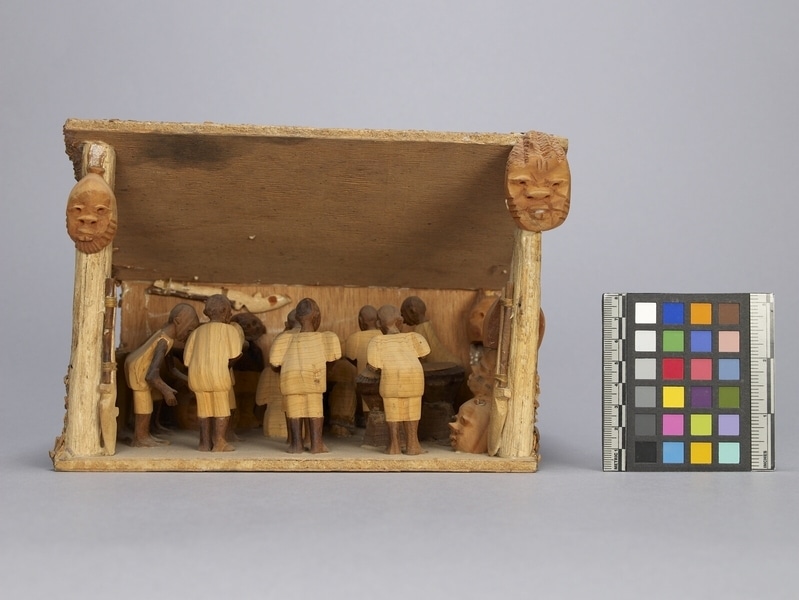Thorn Carving Item Number: Af339 from the MOA: University of British Columbia



Description
Rectangular shed with open front and plywood floor, half sidewalls, back wall, and roof. Outside of roof and walls are covered with variegated thorn shavings. Large upright posts at left and right front support sloping roof. Each post has a large carved, ritual human face suspended from the top. Inside, there are figures representing people. Three ritual human figures and two large carved ritual heads are leaning against the centre of the rear wall. Gun hangs above the left figure while two others lean against the inner sides of the front poles. Three ritual carved human heads are stacked inside the right front post and one rests on the rear of the right sidewall. Facing ritual figures, there is a sitting man with a long hair or a headdress, clothed, and hands extended. At his right, there is an animal with a rope around his neck. Behind him in a semi-circle, there are nine men with bare heads, forearms, and feet. They are wearing tunics and pants. They are facing the ritual figures. At the right rear, there is standing a drummer playing an hourglass drum. Clothes, parts of guns, animal, some ritual heads, parts of ritual figures, and drumhead are light yellow-brown. Human skin, heads, and parts of ritual figures are dark brown. Some carved heads are light red-brown.
History Of Use
Thorn carvings are miniatures depicting scenes from Nigerian life. This type of carving began circa 1930. Thorns vary in size, they can be as large as 12.7 cm. long and 9.6 cm. wide. They are comparatively soft and easily carved. The light yellow-brown thorn and the dark brown thorn come from the Ata tree; the light red-brown thorn comes from Egun trees. The parts are glued together with viscous paste made from rice cooked with water. They are carved by men.
Iconographic Meaning
Depicts an Ogun ceremony. Ogun is the god of iron and patron of all who use iron tools. He is the patron of hunters and warriors. He is also the patron of blacksmiths, woodcarvers, leatherworkers, barbers, and of those who perform circumcision and cicatrization, as well as, in recent times a patron of locomotive and automobile drivers. Ogun is the owner of iron and of the palm fronds used to make his shrines. He also owns the dogs, sacrificed and eaten in his name. A machete, a gun, or any piece of iron can be used as Ogun's symbol.
Cultural Context
craft; tourist art
Item History
- Made in Nigeria before 1972
- Collected during 1972
- Owned by Andrew Stewart and Jessie Stewart before February 8, 1980
- Received from Andrew Stewart (Donor) and Jessie Stewart (Donor) on February 8, 1980
What
- Name
- Thorn Carving
- Identification Number
- Af339
- Type of Item
- carving
- Material
- egun thorn, atum thorn, rice adhesive, stain and wood
- Manufacturing Technique
- carved and glued
- Overall
- height 16.3 cm, width 24.0 cm, depth 17.5 cm
Who
- Culture
- Yoruba
- Previous Owner
- Andrew Stewart and Jessie Stewart
- Received from
- Andrew Stewart (Donor) and Jessie Stewart (Donor)
Where
- Holding Institution
- MOA: University of British Columbia
- Made in
- Nigeria
When
- Creation Date
- before 1972
- Collection Date
- during 1972
- Ownership Date
- before February 8, 1980
- Acquisition Date
- on February 8, 1980
Other
- Item Classes
- carvings & sculpture
- Condition
- poor
- Accession Number
- 0590/0025